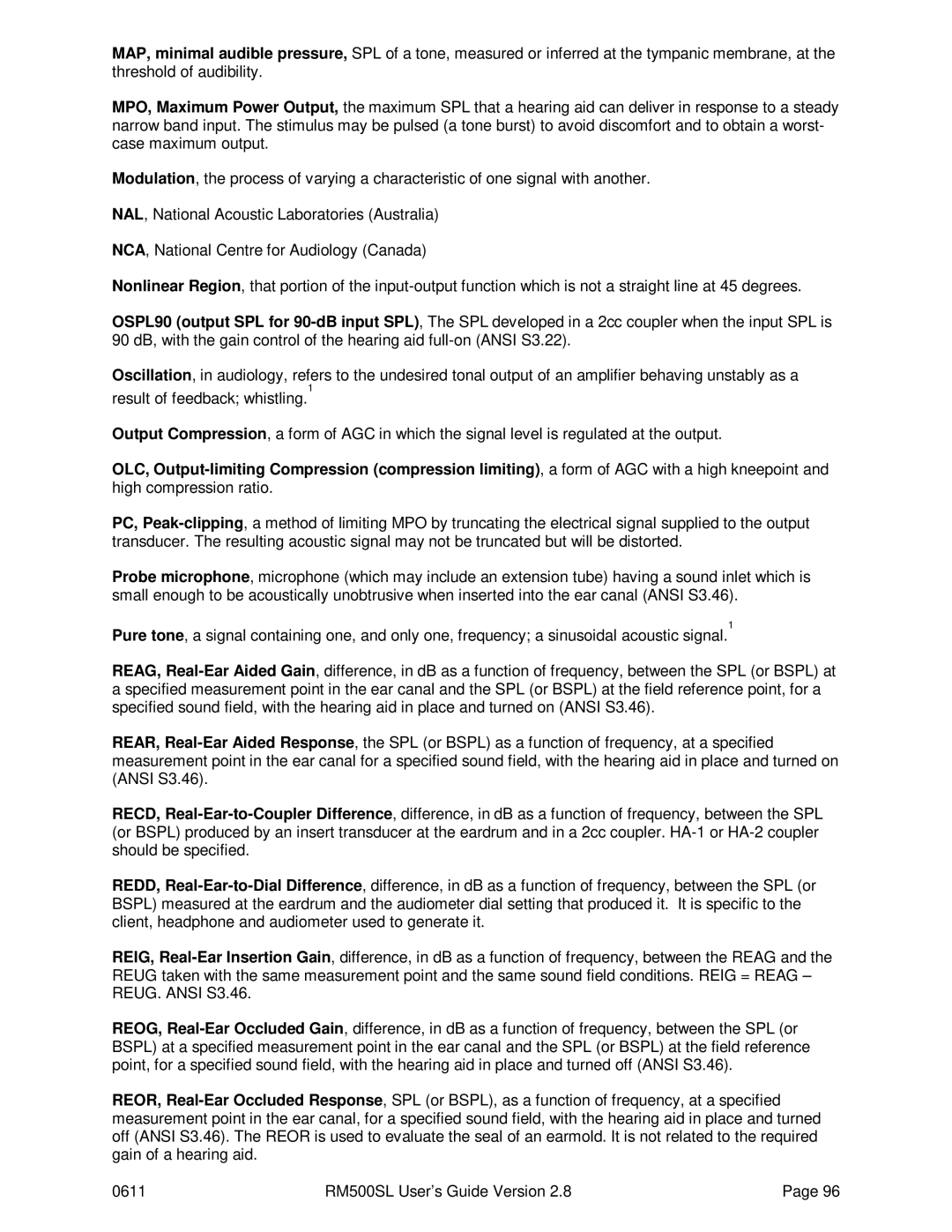MAP, minimal audible pressure, SPL of a tone, measured or inferred at the tympanic membrane, at the threshold of audibility.
MPO, Maximum Power Output, the maximum SPL that a hearing aid can deliver in response to a steady narrow band input. The stimulus may be pulsed (a tone burst) to avoid discomfort and to obtain a worst- case maximum output.
Modulation, the process of varying a characteristic of one signal with another.
NAL, National Acoustic Laboratories (Australia)
NCA, National Centre for Audiology (Canada)
Nonlinear Region, that portion of the input-output function which is not a straight line at 45 degrees.
OSPL90 (output SPL for 90-dB input SPL), The SPL developed in a 2cc coupler when the input SPL is 90 dB, with the gain control of the hearing aid full-on (ANSI S3.22).
Oscillation, in audiology, refers to the undesired tonal output of an amplifier behaving unstably as a result of feedback; whistling.1
Output Compression, a form of AGC in which the signal level is regulated at the output.
OLC, Output-limiting Compression (compression limiting), a form of AGC with a high kneepoint and high compression ratio.
PC, Peak-clipping, a method of limiting MPO by truncating the electrical signal supplied to the output transducer. The resulting acoustic signal may not be truncated but will be distorted.
Probe microphone, microphone (which may include an extension tube) having a sound inlet which is small enough to be acoustically unobtrusive when inserted into the ear canal (ANSI S3.46).
Pure tone, a signal containing one, and only one, frequency; a sinusoidal acoustic signal.1
REAG, Real-Ear Aided Gain, difference, in dB as a function of frequency, between the SPL (or BSPL) at a specified measurement point in the ear canal and the SPL (or BSPL) at the field reference point, for a specified sound field, with the hearing aid in place and turned on (ANSI S3.46).
REAR, Real-Ear Aided Response, the SPL (or BSPL) as a function of frequency, at a specified measurement point in the ear canal for a specified sound field, with the hearing aid in place and turned on (ANSI S3.46).
RECD, Real-Ear-to-Coupler Difference, difference, in dB as a function of frequency, between the SPL (or BSPL) produced by an insert transducer at the eardrum and in a 2cc coupler. HA-1 or HA-2 coupler should be specified.
REDD, Real-Ear-to-Dial Difference, difference, in dB as a function of frequency, between the SPL (or BSPL) measured at the eardrum and the audiometer dial setting that produced it. It is specific to the client, headphone and audiometer used to generate it.
REIG, Real-Ear Insertion Gain, difference, in dB as a function of frequency, between the REAG and the REUG taken with the same measurement point and the same sound field conditions. REIG = REAG – REUG. ANSI S3.46.
REOG, Real-Ear Occluded Gain, difference, in dB as a function of frequency, between the SPL (or BSPL) at a specified measurement point in the ear canal and the SPL (or BSPL) at the field reference point, for a specified sound field, with the hearing aid in place and turned off (ANSI S3.46).
REOR, Real-Ear Occluded Response, SPL (or BSPL), as a function of frequency, at a specified measurement point in the ear canal, for a specified sound field, with the hearing aid in place and turned off (ANSI S3.46). The REOR is used to evaluate the seal of an earmold. It is not related to the required gain of a hearing aid.
0611 | RM500SL User’s Guide Version 2.8 | Page 96 |
